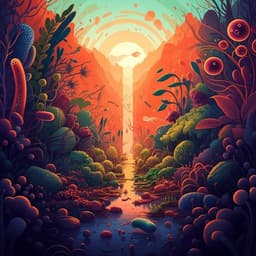
Food Science and Technology
A glimpse of antimicrobial resistance gene diversity in kefir and yoghurt
A. G. Tóth, I. Csabai, et al.
This groundbreaking study, conducted by a team of researchers including Adrienn Gréta Tóth and István Csabai, explores the diverse arsenal of antimicrobial resistance genes found in kefir and yoghurt. Using a cutting-edge metagenomic approach, the research reveals significant findings that call for careful monitoring of starter culture strains to reduce ARG intake in food. Discover the implications for food safety and public health.
~3 min • Beginner • English
Introduction
The study addresses how fermented dairy products, particularly kefir and yoghurt, may serve as sources of antimicrobial resistance genes (ARGs) that can enter the human gut and potentially transfer to commensal or pathogenic bacteria via horizontal gene transfer (HGT). AMR is driven by selective pressure from antibiotic use in human and veterinary medicine, amplifying bacteria carrying ARGs. Because fermented foods contain high bacterial loads, they may introduce ARGs that could be mobilized in the gut. The purpose is to characterize the diversity and abundance of ARGs in kefir and yoghurt (grains, products, and isolated strains) using a unified metagenomic pipeline, and to assess potential mobility and changes in ARG abundance during fermentation. The work is important for public health as it informs on dietary ARG exposure and the need to monitor starter cultures.
Literature Review
Methodology
Data sources: The authors shotgun-sequenced one kefir and one yoghurt starter culture (PRJNA644779) and retrieved 33 additional short-read datasets from NCBI SRA across 8 BioProjects, covering kefir grains (n=4), kefir products (n=15), kefir strains (n=7), a yoghurt grain (n=1), and yoghurt products (n=5). Some projects had peer-reviewed descriptions (PRJNA222257, PRJEB15432, PRJEB30083). Walsh et al. PRJEB15432 provided time-series kefir fermentation data (milk, 8 h, 24 h).
Wet-lab (PRJNA644779): Total metagenomic DNA from kefir (k_g_04) and yoghurt (y_g_01) seed cultures was extracted (UltraClean Microbial DNA Isolation kit), quality-checked (Agilent Tapestation 2200), libraries prepared (NEBNext Ultra II DNA Library Prep for Illumina), and sequenced on Illumina NextSeq (paired-end; 300-cycle kit). Read counts: kefir 22,044,496; yoghurt 20,895,112. Base-calling: bcl2fastq v2.17.1.14.
Bioinformatics: Reads were quality-filtered and trimmed with Trimmomatic (quality threshold 15, min length 50 bp). Taxonomy classification with Kraken2 (k=35) against NCBI NT: initial run default to select bacterial reads, then a stricter run (confidence 0.5) for species-level assignments. Analyses in R with phyloseq and microbiome packages; only reads classified to Bacteria were retained.
Assembly and ARG detection: Bacterial reads assembled into contigs with MEGAHIT v1.2.9 (default). ORFs predicted using Prodigal. Protein translations aligned to CARD v3.0.9 using RGI v5.1.0 with Diamond. Only ORFs classified as perfect or strict with ≥90% identity and ≥60% coverage to reference ARGs were retained. Results reported both including and excluding “nudged” hits (alignments that start internally on the reference were treated separately; a stricter subset required alignments from the reference start).
ARG abundance quantification: For the ith contig, FPKM_i = q_i/(l_i × Q) × 10^6, where q_i is the number of reads mapping to the contig (Bowtie2 very-sensitive-local), l_i is contig length, and Q is total mapped reads. ARG-related contigs were also taxonomically assigned via Kraken2 against NCBI RefSeq complete bacterial genomes.
Mobile genetic elements (MGE): Predicted proteins on contigs were scanned with HMMER against PFAM v32 and TnpPred; best hits with E ≤1e-5 within ±10 ORFs of an ARG were recorded and categorized (phage integrase, resolvase, transposase, transposon). Plasmid-origin probabilities for contigs were estimated with PlasFlow v1.1.
Community/β-diversity and statistics: Bray–Curtis dissimilarities were computed from relative abundances of ARG-harbouring contigs. PERMANOVA assessed associations with sample type, source, and BioProject. PCoA visualized sample ordination. A linear model tested the relationship between sequencing depth (bacterial read count) and detected ARG ORF coverage.
Fermentation dynamics analysis: For PRJEB15432 time-series, only ARGs with maximal coverage >75% across time points were included. ARG abundance changes during fermentation were related to relative abundances of likely source species by mapping reads to reference genomes of implicated taxa.
Key Findings
- Bacteriome composition: Kefir grains were dominated by Lactobacillus kefiranofaciens (57.7% ± 40.5%), L. kefiri (15.7% ± 17%), Streptococcus thermophilus (15.4% ± 30.8%), Lactococcus lactis (6.8% ± 13.5%), Leuconostoc mesenteroides (1.7% ± 3.4%), Leuconostoc pseudomesenteroides (1% ± 2%), and L. helveticus (1% ± 0.7%). Yoghurt products were dominated by S. thermophilus (83.9% ± 13.8%), L. delbrueckii (10.1% ± 16.2%), L. acidophilus (4.6% ± 3.3%), and Bifidobacterium animalis (1.2% ± 2.1%).
- ARG abundance (FPKM): Highest in kefir strains (mean 282, SD 51.1), followed by kefir products (240 ± 78.6) and kefir grains (209 ± 106). Yoghurt had lower abundances: yoghurt grain 17.9; yoghurt products 45.7 ± 32.2.
- β-diversity of resistomes: PERMANOVA on Bray–Curtis distances showed sample type explained 22.17% of variance (p < 0.001), source 18.92% (p < 0.001), and BioProject 35.56% (p < 0.001), indicating a strong project-of-origin effect.
- ARG counts by sample category (strict/perfect matches): Kefir product contained 22 distinct ARGs, kefir grain 2, kefir strains 1. Yoghurt product 1 and yoghurt grain 2.
- Drug classes affected: Across samples, detected ARGs could undermine aminocoumarins, aminoglycosides, carbapenems, cephalosporins, cephamycins, diaminopyrimidines, elfamycins, fluoroquinolones, fosfomycins, glycylcyclines, lincosamides, macrolides, monobactams, nitrofurans, nitroimidazoles, oxazolidinones, penams, penems, peptides, phenicols, pleuromutilins, rifamycins, streptogramins, tetracyclines, and triclosan.
- Likely bacterial origins of key ARGs: In kefir products, many ARGs were on contigs classified to Enterobacter hormaechei (e.g., acrB, acrD, ACT-36, bacA, baeR, CRP, emrB, emrR, marA, mdtB, mdtC, msbA, oqxA, oqxB, ramA, FosA2, and E. coli-associated resistance variants). poxtA was found on contigs attributed to L. helveticus and L. kefiranofaciens; APH(3')-IIb to L. mesenteroides. Kefir grains contained poxtA (L. kefiranofaciens) and lmrD (L. lactis). Yoghurt products had poxtA in L. acidophilus and L. delbrueckii; yoghurt grain ARGs aligned to B. animalis (rifampicin-resistant rpoB variants) and L. delbrueckii (poxtA).
- Resistance mechanisms: In kefir products, dominant mechanisms were antibiotic target protection (50.73%) and antibiotic inactivation (45.45%); smaller contributions from efflux and target alteration. Kefir grains: target protection (91.98%) and efflux (8.02%). Kefir strains and yoghurt products: only target protection detected. Yoghurt grain: target alteration/replacement (51.28%) and target protection (48.72%).
- Mobile elements: One ARG, lmrD in sample k_g_04, co-occurred within 10 ORFs of a transposase ORF, suggesting potential mobility. No ARG-harbouring contigs were predicted as plasmid-derived by PlasFlow.
- Fermentation dynamics (PRJEB15432): APH(3')-IIb was present in all 24 h kefirs from three grains (Fr1, Ick, UK3), absent at most earlier time points except UK3 at 8 h. poxtA was detectable in all samples except Fr1 at 8 h. poxtA fold change at 24 h vs grain: 0.10 (Fr1), 0.59 (Ick), 0.26 (UK3); between 8 h and 24 h: 0.34 (Ick), 0.62 (UK3). APH(3')-IIb contigs mapped to L. mesenteroides; poxtA contigs to L. helveticus and L. kefiranofaciens. APH(3')-IIb abundance increased with L. mesenteroides abundance; poxtA decreased with L. kefiranofaciens.
- Excluding nudged hits (stricter alignment): Four samples with robust matches remained. k_g_04 harboured a lincosamide resistance gene (lmrD; best aligned to L. lactis). y_g_01 had a rifamycin resistance variant (B. animalis rpoB). In PRJNA388572, k_p_14 contained full-length mdtB (aminocoumarin resistance), absent in k_p_15; both had multiple other ARGs conferring broad resistance (aminocoumarin, aminoglycoside, carbapenem, cephalosporin, cephamycin, diaminopyrimidine, elfamycin, fluoroquinolone, fosfomycin, glycylcycline, macrolide, monobactam, nitrofuran, nitroimidazole, penam, penem, peptide, phenicol, rifamycin, tetracycline, triclosan). These contigs best aligned to E. hormaechei.
- Sequencing depth effect: Linear modeling showed that each additional 100,000 bacterial reads increased reference ARG coverage by detected ORFs by 7% (p < 0.0001). Downsampling high-depth samples to the average of other samples (~677,340 reads) decreased median ARG ORF coverage from 99.21% to 16.10%, retaining only lmrD in k_g_04.
Discussion
The unified metagenomic analysis demonstrates that fermented dairy products, especially kefir, can harbor diverse and abundant ARGs relative to yoghurt. The higher ARG burden in kefir may relate to fungal co-cultures exerting antibacterial pressures that select for resistant bacteria. Identified ARGs span many clinically important drug classes, raising concerns that foodborne bacteria could act as ARG reservoirs capable of HGT in the gut under conducive conditions. The study links specific ARGs to dominant fermenting bacteria: poxtA in Lactobacillus helveticus/kefiranofaciens and APH(3')-IIb in Leuconostoc mesenteroides, and shows that their abundances track with the relative abundances of these taxa during fermentation, supporting the hypothesis that fermentation amplifies ARG content via bacterial growth.
Mobility analysis suggested limited potential for horizontal transfer within the dataset, with only lmrD showing genomic proximity to a transposase. No plasmid-borne ARG contigs were identified. Despite common β-lactam use in dairy cattle, β-lactam resistance determinants were not prominent, and several ARGs were associated with antibiotics not used in dairy animals, implying complex sources and possible non-farm origins. The pronounced BioProject effect indicates that sampling, processing, or environmental factors strongly shape resistome profiles.
Collectively, these findings address the research question by showing that kefir and yoghurt differ in ARG diversity and abundance, that fermentation can alter ARG levels in concert with specific taxa, and that starter cultures are likely key inputs influencing food resistomes. This underlines the relevance of monitoring and selecting starter strains to minimize dietary ARG exposure.
Conclusion
This study provides a comprehensive metagenomic snapshot of antimicrobial resistance genes in kefir and yoghurt grains, products, and strains. Kefir exhibited substantially higher ARG abundance than yoghurt. ARGs affecting numerous critical antibiotic classes were detected, with poxtA and APH(3')-IIb as prominent examples linked to Lactobacillus and Leuconostoc species. Fermentation dynamics analyses showed ARG abundances change alongside shifts in their likely source taxa. Only limited evidence of potential mobility (lmrD near a transposase) was found.
The results advocate for routine genetic monitoring and careful selection of starter cultures to reduce ARG intake via fermented foods. Future work should include standardized, longitudinal sampling of starter cultures and products across fermentation time points, deeper sequencing (≥20 million clusters) to robustly capture ARGs, assessment of MGE contexts and plasmid carriage, and evaluation of the transferability and expression of foodborne ARGs in gut-relevant conditions.
Limitations
- Heterogeneous datasets across multiple BioProjects introduced a strong project-of-origin effect on resistome profiles, potentially reflecting differences in sampling, processing, or sequencing protocols.
- Limited sample sizes for some categories (e.g., only one yoghurt grain) constrain generalizability.
- Detection of ARGs is sensitive to sequencing depth and assembly quality; shallower datasets showed reduced ORF coverage, and absence of genes may reflect assembly limitations rather than true absence.
- Plasmid origin prediction and MGE context analyses may miss low-abundance or fragmented mobile elements.
- The reliance on database alignments (CARD) and filtering thresholds (identity/coverage; nudged vs non-nudged) can affect ARG calls and may under- or overestimate true ARG diversity.
- Functional activity and transferability of detected ARGs were not experimentally validated.
Related Publications
Explore these studies to deepen your understanding of the subject.







